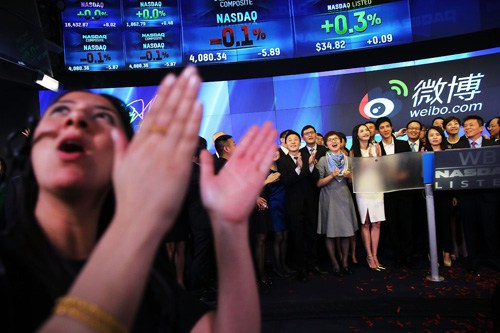|
 |
|
WELCOME ABOARD: People cheer as China's Weibo, a Twitter-like microblogging service company, begins trading on the Nasdaq exchange in New York City on April 17 (XINHUA/AFP) |

U.S. President Barack Obama's vision for better relations with China is based on a time-tested commercial foundation. To enhance his Asia "pivot" strategy and the Trans-Pacific Partnership (TPP) plan, then Secretary of State Hillary Clinton officially launched the "100,000 Strong" educational exchange initiative for American students to study in China. Beijing reciprocated with 10,000 "Bridge Scholarships" for young Americans to be trained in China. All this takes place simultaneously along with unprecedented financial, trade and investment relations that already exist between the two largest economies in the world.
Historical legacy
With the economic rise of China, the American focus has increasingly been shifting from Atlantic to Pacific affairs. The United States and China are now intrinsically interconnected as importer-exporter and consumer-producer nations. This is the enduring legacy of the old and young republics that mutually benefited each other from their respective westward economic strategies of the ancient Silk Road and the Pacific expansion with the Louisiana Purchase (1803) by President Thomas Jefferson.
With the "go west, young man" spirit, America's westward development was further activated by Manifest Destiny with the continental expansion from the Atlantic seaboard to the Pacific coast. Likewise, the Silk Road expanded westward from the ancient Chinese capital of Xi'an to the Asia Minor and Europe millennia ago. The Middle Kingdom's trade-for-peace strategy was intended to form the Confucian vision of a "Celestial Empire." These intelligent designs and traditions still continue with greater sophistication by both countries.
The American republic—even since the Pilgrims and colonists arrived in the New World—searched for a "short cut" to trade with China. With the Louisiana Purchase and the Lewis and Clark Expedition (1804-06), the United States found its way to the Pacific Northwest to connect with the Middle Kingdom in shorter distance than going around the Cape Horn in Latin America or the Cape Good Hope in Africa. New settlers in the western and northern corridors of America built their own railroad civilization with the development of the Pacific Union and the Northern Pacific railroad systems. The American vision to reach out to the Middle Kingdom has essentially created a new frontier civilization in the Pacific West.
Our founding fathers were also inspired by the Chinese civilization and wanted to develop their own commercial civilization in the Atlantic seaboard. Charles Thomson, secretary of the Continental Congress, wrote that "this country may be improved beyond" what "might have been expected" if we could be "so fortunate as to introduce the industry of the Chinese, their arts of living and improvements in husbandry, as well as their native plants, America might in time become as populous as China, which is allowed to contain more inhabitants than any other country."
Moreover, George Washington imported Chinese plants for his Mount Vernon estate, Thomas Jefferson adapted Chinese architectural designs for his Monticello residence, and Benjamin Franklin used Confucian ideas in his Poor Richard's Almanack. While creating wealth from China trade, a growing number of rich families from Boston to Charleston flourished with the commercial culture of exporting American ginseng and fur while importing Chinese tea, silk and porcelain.
| 